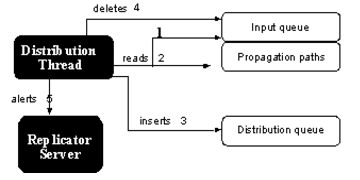Distribution Threads
The distribution threads put the destination address on the replication that needs to be propagated. The distribution threads work in parallel to clear the input queue.
The distribution threads work within the DBMS Server to take the information from the input queue and expand it to fully specify what data needs to be replicated to which targets. The expanded information is stored in the distribution queue. The distribution threads do not perform any replication; they merely prepare data for replication by the Replicator Server. However, no data is expanded to the distribution queue if the threads are not configured. There can be a number of threads in each DBMS Server.
How the Distribution Thread Works
The distribution thread performs the following tasks:
1. Reads a record from the input queue to obtain the replication information.
2. Obtains destination information from the propagation paths table.
3. Inserts a row into the distribution queue for every destination of the replication.
The number of rows a distribution thread inserts into the distribution queue per replication is equal to the number of targets that you have defined for that replication’s Consistent Distributed Data Set (CDDS). Each row contains the information from the input queue plus the destination information.
4. Deletes the replication’s rows from the input queue.
5. Alerts the Replicator Server associated with the replication’s CDDS.
The following figure illustrates the tasks of the distribution thread:

Last modified date: 01/30/2023